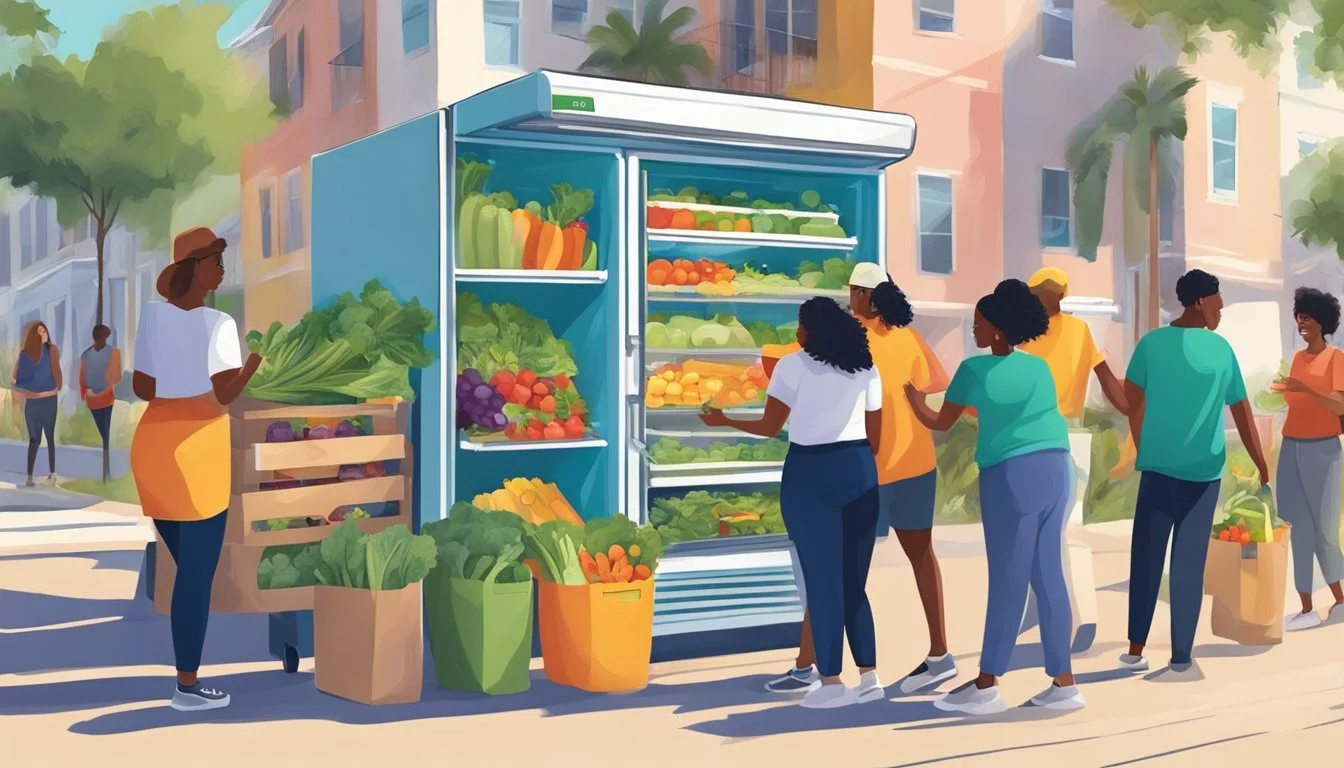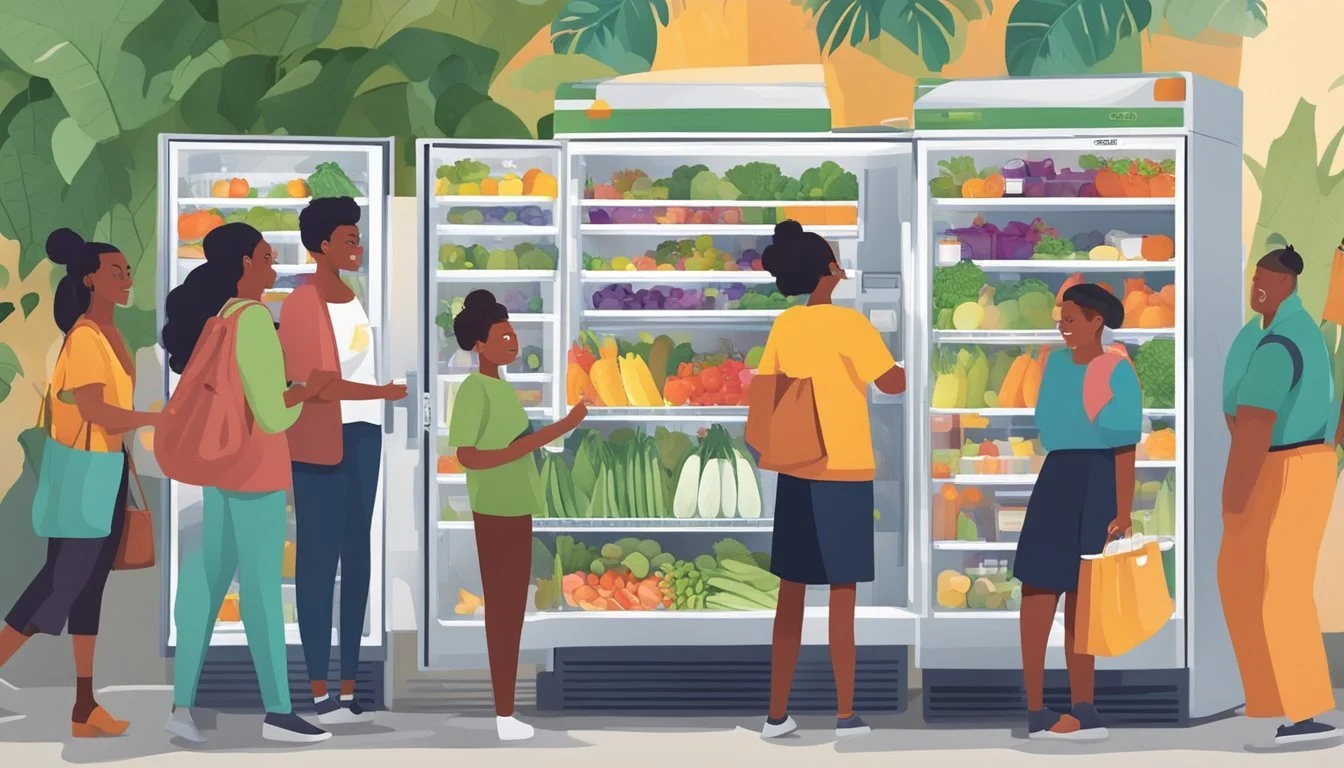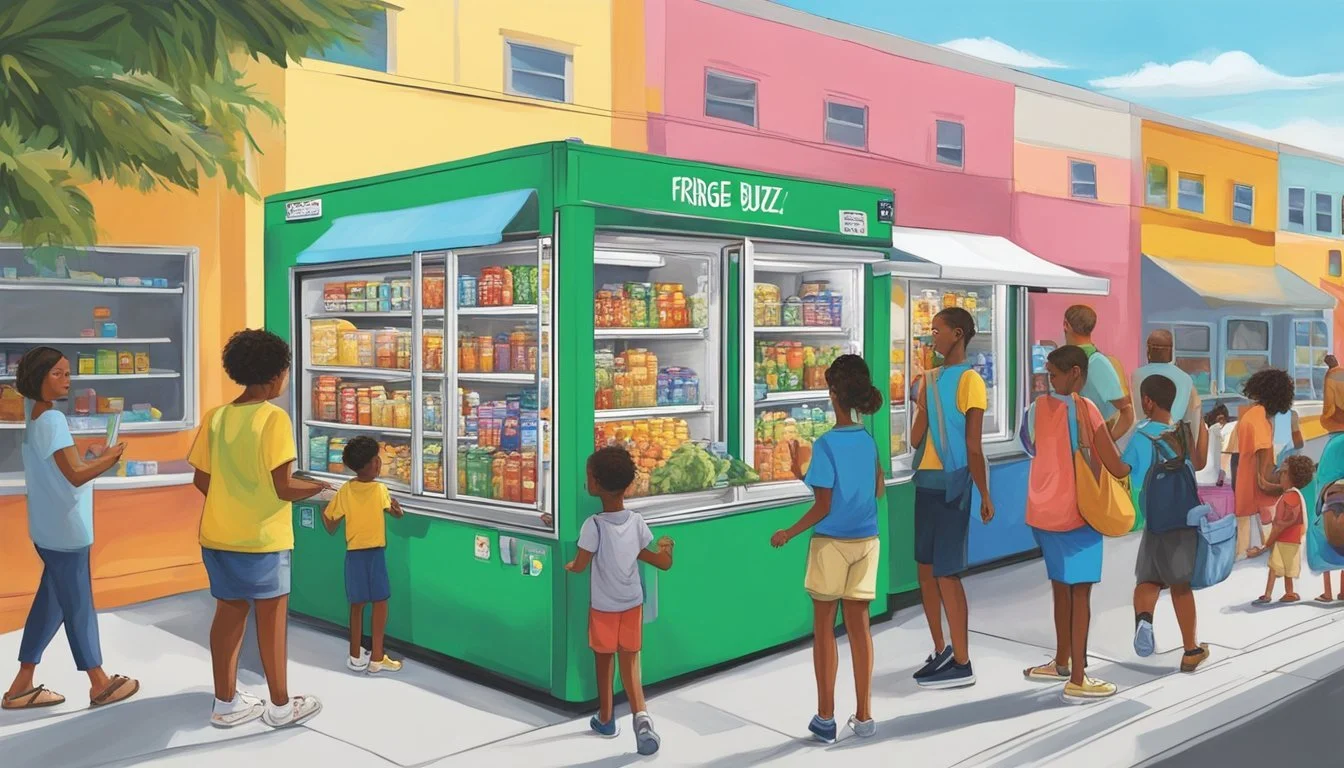Tampa, FL Community Fridge
Bridging the Gap in Food Security
Community fridges in Tampa, FL, are emerging as a grassroots solution to food insecurity and food waste. These refrigerators are placed in public spaces, creating a decentralized network where individuals can access fresh food at no cost. The initiative leverages the abundance of food that would otherwise be discarded, enabling community members to share and reduce waste while supporting those in need.
The Tampa-St. Petersburg Metropolitan Area is home to several community fridges, each maintained by volunteers and sustained through donations. These fridges are accessible to everyone, embodying the principle of taking what you need and giving what you can. The presence of these fridges in Tampa not only provides immediate relief to residents but also fosters a sense of community and mutual aid.
As the network of community fridges continues to grow in Tampa, it becomes a testament to the city's commitment to caring for its residents. The fridges, often adorned with artwork, stand as symbols of solidarity, challenging the traditional ways of addressing hunger and inspiring other communities to adopt similar models of shared responsibility and community support.
Community Fridge Concept
Community fridges in Tampa, FL, offer a solution to food insecurity and food waste through a network of free fridges run by nonprofit entities and local community members.
Understanding Community Fridges
Community fridges are public refrigerators where individuals and businesses can leave surplus food for others to take freely. This concept addresses two critical issues simultaneously: food insecurity—the state of being without reliable access to a sufficient quantity of affordable, nutritious food—and food waste. By providing an easily accessible location, community fridges allow for perishable food items to be shared before they spoil, reducing waste and providing assistance to those in need.
Key Elements:
Food Sharing: Allows surplus food to be shared rather than discarded.
Accessibility: Typically located in public spaces and open to everyone.
Community-based: Managed and maintained by the local community or nonprofit organizations.
History and Growth
The community fridge concept has seen significant growth, particularly in urban areas like Tampa, FL. Originally spurred by a global recognition of food waste challenges and the pressing need to address food scarcity, these fridges have been introduced by activists and community organizations. The fridges are a testament to community solidarity and collective efforts in fostering resource sharing.
Timeline Overview:
Inception: Initiated by community activists and nonprofit groups.
Expansion: Growth seen as the fridge concept proves effective in addressing local needs.
Network: Development of a community fridge network enhancing the reach and impact across Tampa.
In Tampa, the Community Fridge Network plays a pivotal role in organizing and maintaining these units, ensuring that the fridges are stocked, clean, and safe for public use. The network also helps in raising awareness about the fridges, connects with local businesses for contributions, and promotes the fridges as a reliable resource within the community.
Setting Up a Community Fridge
Implementing a community fridge in Tampa, Florida, necessitates careful planning, collaboration with local entities, and adherence to health regulations to ensure it serves as a beneficial resource for the local community.
Location Selection
Selecting the right location for a community fridge is paramount. It should be accessible to those in need and situated in a well-frequented area to encourage donations. Ideal locations may include public spaces near elementary schools or community centers, such as the Yung Ho Martial Arts Center, where there’s a natural flow of individuals who can both benefit from and contribute to the fridge.
Appliance Sourcing
The next step is obtaining the appropriate appliances. A community fridge requires a reliable refrigeration unit that can withstand constant use and fluctuating outdoor conditions if not placed indoors. Collaboration with appliance providers or seeking donations from local businesses can offset initial costs. Appliance repair services can also be solicited to maintain the unit, ensuring the owner or responsible party keeps the fridge in optimal working condition for community use.
Regulatory Compliance
Ensuring the community fridge complies with local health and safety regulations is critical to avoid potential legal issues and health risks. This entails securing necessary permits, setting stringent cleaning standards, and maintaining regular upkeep. The fridge must be kept clean, with a clear fridge cleaning logbook, and food stored within it should meet all regulatory compliance standards for food safety. Engaging with local health departments can provide guidelines on how the local community can safely manage and utilize the fridge.
Tampa’s Community Fridge Initiatives
In Tampa, FL, community fridge initiatives are tackling food insecurity and reducing food waste through accessible public spaces and support from local organizations and businesses.
Ybor City Fridge
In the historic district of Ybor City, compassionate community members established a free fridge to address food scarcity during the COVID-19 pandemic. This fridge, and others like it in the Tampa Bay area, operate on the principle of take what you need, leave what you can. Such initiatives have been supported by local groups including Food Not Bombs that often contribute surplus food to help those in need.
Freedge Movement
Tampa's participation in the freedge movement is characterized by refrigerators placed around the city, including in neighborhoods such as St. Pete. These fridges receive donations of perishable foods from individuals, community groups, and local businesses, exemplifying community solidarity. Over a period of a few months, a single community fridge can redistribute significant amounts of food and offer thousands of dollars in savings to local households and community groups.
Promoting Food Security
Tampa's Community Fridge initiative represents a beacon of hope for combating food insecurity. It operates on the core principles of dignity, accessibility, and community support.
Addressing Food Insecurity
The Community Fridge in Tampa Bay tackles food insecurity by providing free food to individuals and families in need. These fridges are stocked with perishable and non-perishable items, allowing easy access to nutritious food. The honor system ensures mutual respect and trust within the community.
Volunteer Opportunities
Volunteers are the backbone of the Community Fridge project. Their roles include:
Stocking and Cleaning: Ensure the fridge is well-stocked and maintained.
Food Rescue: Transport surplus food from donors to the fridge.
A few hours a week can make a substantial difference in someone's life.
Businesses' Role
Local businesses contribute significantly to the sustainability of Community Fridges. Their involvement includes:
Donations: Surplus food is redirected to the fridges rather than going to waste.
Sponsorship: Financial or resource-based support keeps the project running.
This collaboration demonstrates businesses' commitment to social responsibility and community well-being.
Impact of the Pandemic
During the coronavirus pandemic, food insecurity became a pressing issue in Tampa, FL, leading to initiatives such as the establishment of community fridges to offer mutual aid.
COVID-19 Challenges
The onset of the COVID-19 pandemic resulted in unforeseen hardships for Tampa's residents. Job loss and economic instability escalated the issue of food scarcity. Florida reported the second-highest rate of food insecurity in the nation, reflecting the pandemic's severe disruption to families’ access to nutritious food.
Community Response to Crisis
In response, community fridges—simple yet innovative mutual aid resources—became prominent in Tampa and St. Petersburg. Locals stocked these "free fridges" with food, making provisions accessible to those in need. The fridges represented a community-driven effort to address the heightened demand for food aid and captured the spirit of resilience and solidarity amidst the crisis. Community support remained steadfast, even as the initial peak of the pandemic passed.
Partnerships and Support
The success of the Tampa Community Fridge initiative can largely be attributed to the robust partnerships and strong support it has received from the local community and businesses. These collaborations have been instrumental in providing Tampa residents with access to nutritious food, whilst fostering community connections and reducing waste.
Collaborations with Local Businesses
Local businesses play a crucial role in the sustainability of the Community Fridge. They contribute surplus food that would otherwise go unused, supporting the fridge with a steady supply of nourishing options. This act of giving not only benefits recipients but also aids these businesses in cutting down on food waste—a win for both the community and the environment.
Contributing Businesses:
Local bakeries
Grocery stores
Farmers markets
Restaurants
Key individuals, such as Cassidy Boe, have been notable for their commitment to forming these essential business partnerships.
Educational Outreach
The community fridge doesn't operate in isolation; educational outreach is a significant part of its framework. Through educational programs, community members like Jany Coyle have taken the initiative to inform both donors and recipients about the importance of the fridge within the community. These educational efforts emphasize food safety, the benefit of sharing resources, and the overall impact on community wellness.
Key Educational Points:
Food sharing best practices
Nutritional information
Waste reduction strategies
Engaging the community on these fronts ensures that the fridge remains a safe, reliable, and well-utilized resource
The Tampa Bay area is witnessing a notable initiative in the form of the Community Fridge, designed to tackle food waste and insecurity while fostering community growth and sustainability.
Long-Term Management
The success of Tampa's Community Fridge hinges on the effectiveness of its long-term management strategies. These strategies encompass regular check-ins and maintenance to ensure food safety and quality. Coordination with local businesses to secure a steady influx of surplus food is crucial. Reinforcing the initiative's sustainability, the management includes volunteer programs that empower residents to take part in their community's well-being.
Food Safety: Regular monitoring for freshness.
Community Volunteers: Scheduled staffing to maintain operations.
Business Partnerships: Continuous collaboration for surplus provision.
Expansion Efforts
As for growth, the Community Fridge network looks to expand its reach within the state, aiming to establish more locations to better serve Tampa residents. Each new fridge joins the network's mission to:
Increase Access: Making nutritious foods more readily available.
Community Connectivity: Strengthening ties between residents and local businesses.
Environmental Responsibility: Reducing waste and promoting eco-friendly practices.
By addressing these areas, Tampa's Community Fridge positions itself as a keystone for communal sustainability and a model for growth in similar initiatives throughout Florida.
Engaging the Public
In Tampa, Florida, the Community Fridge initiative aims to tackle food insecurity through public involvement and collaborative efforts. They’ve harnessed social media, community events, and grassroots engagement to raise awareness and build a foundation of trust within the local community.
Raising Awareness
To effectively raise awareness, the organizers of the Community Fridge in Tampa ensure their presence is visible and active both online and in physical community spaces. They harness the power of social media to reach a broad audience, providing updates on food availability and sharing stories of the project's impact. They also recommend ways in which the community can get involved, whether through donations or volunteering.
Physical signage has been installed near each fridge, offering clear and honest information about how to use the service or contribute. This visual component not only informs but also invites passersby to become a part of the movement.
Building Trust
Building trust is paramount to the success of community-driven projects. The team behind the Tampa Community Fridge works to create a friendly environment around each fridge location. By hosting events and maintaining a consistent presence, they foster a sense of ownership and responsibility among local residents.
The project actively seeks reviews and feedback to ensure they are meeting the community's needs and addressing any concerns promptly and empathetically. By demonstrating transparency in their operations and showing a genuine dedication to serving those in need, the trust between the community and the initiative continues to strengthen.
Conclusion
Tampa's adoption of community fridges, also known as free fridges or 'freedges', showcases the city's innovative approach to tackling food insecurity and reducing waste. Local businesses and individuals play a significant role in stocking these fridges, which are strategically placed throughout the area to provide easy access to fresh, nutritious food for those in need.
Key Points:
Community fridges have helped thousands of residents connect with each other, access food, and save money.
They also contribute to the reduction of food waste by redistributing surplus items.
The success of the community fridge concept in Tampa is evidenced by their continued use and growth, even after the peak of the COVID-19 outbreak. Through these communal food-sharing initiatives, it is evident that communities have the potential to come together to support their most vulnerable members while promoting sustainability.
Impact:
Tangible Support: Residents benefit directly from the free food provided.
Community Engagement: The fridges encourage local participation and foster community spirit.
Sustainability: They promote a more eco-friendly approach to food consumption by utilizing excess produce that might otherwise go to waste.
These refrigerators serve as more than just food distribution points; they symbolize Tampa Bay's commitment to building resilient communities through shared responsibility and caring. The continued operation of community fridges in Tampa Bay is a powerful statement of collective effort and mutual aid, encapsulating an innovative response to social challenges.










